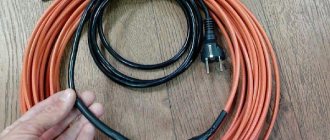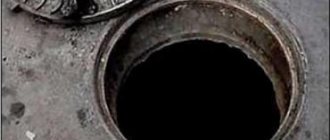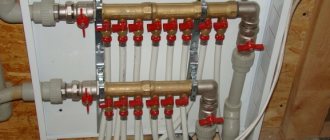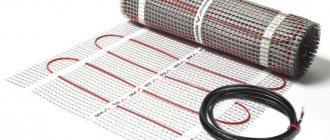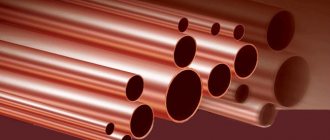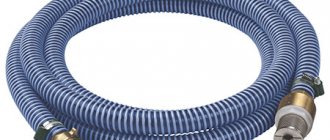Let's put everything in order.
- When is cable heating of pipelines needed in a residential building?
In two cases:
- When the hot water supply or hot water supply (in the latter case, a dead-end, without continuous circulation) is laid through a room with a temperature below +2°C;
However: SP 30.13330.2016 allows the use of thermal support along with cable heating, that is, laying a water supply in a common channel with heating or another heat source.
- When water supply or sewerage, for some reason, cannot be laid below the soil freezing depth.
Freezing depths in different regions of the Russian Federation
- What kind of heating cable for heating pipes can be found on sale?
Here is a list of its varieties:
- Single-core resistive
is a single conductor with high electrical resistance in an insulating sheath. Sometimes it is equipped with a shielding braid that is connected to ground and is designed to protect electronic equipment located near the cable from induced stray currents; - Twin-core resistive
, as the name suggests, differs from its closest relative only in the presence of two conductors in common insulation;
Resistive cable heaters - single-core and double-core
- A zone heating cable
for a pipeline includes two low-resistance current-carrying conductors connected by heating elements;
Zone cable device
- A self-regulating heating cable
for pipes consists of a pair of current-carrying wires and a matrix of high-expansion polymer located between them, when heated with the addition of fine conductive material (for example, graphite dust).
Self-regulating heater structure
Who is better
Economical
- Which pipeline heating cable consumes less energy?
Self-regulating. You see, its matrix changes its electrical resistance depending on the ambient temperature and the cable itself:
- In cold weather, the matrix reduces its linear dimensions. At the same time, the conductive particles in it form a larger number of circuits that close the current-carrying conductors with each other, which causes an increase in the current consumed by the cable section and its heating;
- At a constant cable temperature, the size of the matrix is unchanged, which means its resistance is also unchanged;
- As soon as the cable heats up due to an increase in the temperature of the environment, the matrix will expand, and the number of current-carrying circuits in it will drop, followed by a drop in power consumption
Matrix behavior under temperature changes
What is the result? As a result, the cable consumes exactly the amount of energy needed to maintain a stable temperature. Not only that: for each section of the cable, energy consumption is regulated independently of other sections.
fault tolerance
- What type of heating cable is most reliable?
With proper installation, all its varieties remain operational indefinitely: there is simply nothing to break in an insulated conductor. However, unlike its competitors, the self-regulating heating cable for pipes is not afraid of overlap: it can be powered even when the cable is wound into a coil.
Any resistive or zonal cable under the same conditions will immediately go to Valhalla due to local overheating in places of overlap and the associated melting of the insulation: the heat release of the conductor will exceed the heat removal capabilities.
Hint: our hero is saved by the same independent power adjustment of each individual section. As the matrix heats up at the overlap site, it will reduce the electrical resistance and reduce heat generation.
cutting
- What kind of cable can be cut into sections of arbitrary length?
The same self-regulating heating cable for pipes. The fact is that the length of the current-carrying wires does not in any way affect the heating of the matrix connecting them: when the cable length decreases, only the total power consumed by the segment decreases.
A piece of any length will retain functionality
How are your competitors doing?
The resistive cable has a fixed length. Its change will entail a decrease in the total resistance of the conductor, followed by an increase in current and overheating.
By the way: a single-core resistive heater has another unpleasant feature. It needs to be connected to power at both ends, which complicates installation. With a two-core cable, this problem is solved by an end coupling that closes the conductors together.
The zonal cable can be cut, but only into sections of a fixed length. If you cut the cable in the middle of a section, you will damage the heating elements in it.
Types of submersible cables
Almost all products are marked with runway letters. It has the following meanings:
- B – products that can be used under water;
- P – insulation made of polyethylene;
- P – shell made of polyethylene.
There are several main types of such products on sale. Among them:
- ERW. It has an additional sheath made of polyvinyl chloride, which increases the resistance of the cable to mechanical loads arising during installation. It is used to connect generators to engines in conditions of constant humidity without stopping the operation of the equipment. The lower permissible temperature is -15°C.
- Runway 6. Used to transport electric current to electric motors located under water. The standard cross-section is 6 mm2. This cable has minimal weight. The insulation and winding are made of waterproof polyethylene. The cable core is made of copper. The wire functions perfectly at low and high temperatures, which vary from -40° to +80°C. The main difference from similar products is the cross-sectional value.
- GDP 4. Power cable, which is often used to create communications for transmitting electric current to pumps and motors operating under water. Consists of a core with a large number of copper wires. The cross section is 4 mm2. The service life may be significantly reduced due to temperature changes or mechanical stress. There is a standardized standard that at +40°C the product will work up to 32,000 hours, and at +80°C - half as much. The minimum service life is 6 years. If you take care of the laid line, the period of use can increase dramatically.
- VPP 10. In terms of use, this cable is no different from the products described above. It differs from analogues in its cross-section, which is equal to 10 mm2. Although the figure is not very impressive, the wire is ideal for enterprises whose activities are closely related to water supply and wells. The structure of this brand of cable is no different from its analogues - a copper core covered with insulation and a polyethylene winding.
These are the four most popular water-submersible cables today. Other brands are also available for sale. Their differences almost always concern only the cross-section of the cores.
Section assembly
- What is needed to organize heating of pipes using a heating cable with a self-regulating matrix?
To begin with, turn it into a ready-made heating section. For this you need:
- Power wire (the so-called cold end). For a heater with a shielding shell, a three-core wire 3x1.5 mm2 is used;
- Eurofork;
Grounding Plug
- Installation kit, including heat shrink of several sizes and sleeves for connecting wires. Its price currently (2017) varies from 200 to 400 rubles.
How to assemble a section with your own hands?
Here are the detailed instructions:
How to check a heating cable for integrity with a multimeter?
Most often, the average consumer encounters a heating cable used for installing heated floors. When the system stops supplying heat to the room, you have to figure out the reasons. There are three main points of failure of a heated floor:
- thermostat;
- temperature sensor;
- heating cable.
If the first two are checked and found to be working, you will have to check the cable.
You can find out about its performance in two ways:
- carry out a visual assessment based on external signs of damage - insulation melting, blackening of a cable section;
- use a measuring device, the most accessible of which is a multimeter.
The check is carried out in the following order:
- The device is set to AC voltage measurement mode and the presence of supply voltage is checked at the thermostat terminals.
- Next you need to check the resistance of the heating cable itself. To do this, the tester is switched to resistance measurement mode.
- The entire system is de-energized, the leads of the heating elements are disconnected from the thermostat terminals and measurements are taken.
- The probes of the device are applied to the cable terminals.
The indicators on the display depend on the power of the cable, which is indicated in the passport for it. Possible results:
- A resistance deviation of 5–10% in both directions is allowed. Therefore, if the actual resistance of the heating cable is within these limits, it is considered to be in good condition.
- Exceeding the resistance indicates insulation damage.
- A resistance indicator tending to infinity signals a possible cable break.
- A resistance equal to zero indicates a short circuit.
If the test shows that the cable is not working, you will have to look for damage and repair it.
Video:
Power selection
- How to choose a self-regulating heating cable for heating pipes of a known diameter?
Refer to the table below:
Heat loss of a pipe depending on its size, quality of thermal insulation and temperature difference with the environment
The total power of the cable per linear meter of pipe must fully compensate for heat loss. For example, for a 20-mm water supply inlet, laid in centimeter-thick thermal insulation along a street with a temperature of -30°C and transporting 10-degree water, you need a cable with a power of at least 17 W/m.
However: the heating cable can be laid on pipelines not only in one line, but also in spiral winding. You will get the same power by winding 1.7 meters of 10-watt cable onto a meter of pipe.
The cable is wound onto the pipe in a spiral
What characteristics are important for selection?
Before going to the store, be sure to check the diameter of the water pipe, the length of the area that needs heating, the lowest possible air (soil) temperature - this will make it easier to make a choice, because there are really a lot of offers.
So, let's pay attention to the following points:
- the presence of a protective film - provides grounding and makes the cable more reliable;
- type of external insulation;
- temperature class and power;
- manufacturing company.
A cable with polyolefin insulation may be suitable for a sewer system, but for internal installation in a water pipe we recommend protection made of fluoroplastic. For outdoor installation, a fluoropolymer is suitable, which will protect both from moisture and ultraviolet radiation.
If it is necessary to heat small-diameter pipes, a low-temperature type conductor is suitable. It heats up to + 65 ºС, maximum power is about 15 W/m
Medium temperature systems are suitable for larger diameter pipes. Maximum heating temperature is +120°C, power reaches 33 W/m.
High-temperature systems with a maximum temperature of up to +190°C and a specific power of up to 95 W/m are considered the most powerful. However, they are usually not used in everyday life - these are products for industrial use.
The appropriate power can be selected based on the diameter of the pipe. For example, for water pipes with a diameter of up to 2.5 cm, cables with a power of 10 W/m are suitable, from 2.5 cm to 4 cm - 16 W/m, from 4 to 6 cm - 24 W/m, etc.
There are several brands of heating cable that have long proven themselves only from the best side.
Famous products of foreign companies:
- Nelson;
- Lavita;
- Devi;
- Ensto;
- Raychem.
Among Russian manufacturers, the company SST ( Teplolux ) stands out, producing high-quality household products.
Pipe mount
- How to attach a cable heating system to a pipeline?
Here are some of the simplest solutions:
- Spiral winding;
- Scotch tape (regular or, which is much better, aluminum: it will reduce heat loss from the pipeline due to infrared radiation);
- Polyethylene ties.
Aluminum tape and polyethylene ties were used to attach the heating system to the sewer pipe.
Resistance calculation example
Let's look at how such a calculation is made. Let's say we have as a test sample a cable of the SRL-16-2 brand, with a power of 16 W/m.
The total length of the site is 10 meters. The temperature of the pipe on which the cable is laid is currently about 5 degrees.
First, let's calculate how much current this self-regulator should consume under such conditions.
(P-power per 1m, L-cable length, U-voltage)
We take power based on the dependence graph. In our situation for 5C it turns out to be approximately 17.5 W/m
Error
Please note that the real voltage must be measured, and not the conventional 220V.
Sometimes it can differ significantly both up and down. Take standard 220V and you will get a significant error that distorts all the data.
I=P*L/U=17.5W*10m/235V=0.74A
Voltage measurements are carried out with the same multimeter. After calculating the current, we calculate the cable resistance.
That is, it turns out that our multimeter, under given “climatic” conditions, should show a resistance within 320 Ohms. This is the calculation:
R=P*L/I2=17.5W*10/0.74A*0.74A=319.5 Ohm
And this is the result:
If its readings differ tenfold, up or down, then something is wrong with the heating cable.
This approach is very conditional and in many respects everything will depend on the temperature of the self-regulating matrix. It is the temperature error that introduces the largest inaccuracies.
It is quite likely that the beginning of the cable will have one temperature, and its end on the frozen pipe at the end of the house will be completely different. In this case, you should not rely 100% on such calculations.
However, again, you can find out at least an approximate order of magnitude.
If the multimeter shows data of several tens or hundreds of kOhms, and the calculated data indicates tens or hundreds of Ohms, then there is clearly something wrong with the cable.
All measurements on self-registers are most often carried out on a multimeter scale of 2000 Ohms, not 200 Ohms.
Thermal insulation
- How to insulate pipes with a heating cable attached to the surface?
And there are several options here:
- Foam shell;
In the photo - a foam shell
- Foil shell made of basalt wool;
- Shell made of polyurethane foam (including foil);
It’s interesting: the modern market offers ready-made pipes in PPU insulation with a heating cable. They are designed for installation of external pipelines in particularly cold regions.
Steel pipe with heating cable: PPU insulation greatly reduces heating costs
- Insulation materials made of foamed polymers (polyethylene foam, polypropylene foam) - tubular and rolled, foil-coated and without an additional reflective layer.
Polyethylene foam pipe casings
Types of heating cable
For electrical heating of pipelines, 2 types of cords are used:
- resistive;
- self-regulating.
Resistive
Stability of operating parameters ensures uniform energy consumption. To reduce heating costs (for example, during thaws or in the spring-autumn period), sensors and a current regulator are introduced into the design of the water pipe heating system.
The resistive type heating cable is made with 1 or 2 cores. Single-core wires are connected to the household AC network from 2 sides. Two-core products are equipped with a connector for connecting to the network or a piece of installation wire with a factory-installed plug.
The opposite side of the cord is closed with a sealed plug (end sleeve). Inside the end element there is a metal insert that ensures the closure of the electrical circuit.
The design of resistive conductors does not provide for cutting the material into sections of the required length. Manufacturers prohibit laying excess wire in coils; it is necessary to mount the entire existing cord onto the pipe section.
When laying resistive elements, it is prohibited to locate the lines next to each other. When placed close to each other or when laying routes intersect, the metal cores overheat and the products fail.
Self-regulating
Operating principle of heating cable
As the temperature increases, the polymer material passes a lower current, which reduces the degree of heating. As the polymer cools, the conducted current increases and the heat transfer of the substance increases. Due to this physical feature of the material, the self-heating cable for water supply automatically regulates the heating temperature of the pipeline or adapter couplings.
Cords with independent heating control can be laid overlapping and next to each other. It is possible to cut the product into sections; there are notches on the outer shell that determine the permissible size of the section.
After separating the required fragment, it is necessary to install a protective end coupling. The disadvantage of the product is the increased cost (compared to resistive elements), but the service life increased to 10-12 years compensates for the increased costs of purchasing the material.
Pipeline installation
- Is it possible to install a heating cable inside a water pipe?
Can. The cold end connection and end sleeve are sealed and will reliably protect the conductor and matrix from short circuits. Of course, the cable should not pass through shut-off and control valves (including full bore ball valves and gate valves).
The cable is inserted into the water supply inlet to the tap
- How to insert a heating cable inside a pipe and ensure its tightness?
Through a tee with an elastic seal. It is installed inside the house, immediately after the entrance crosses the outer wall.
The gland seal allows you to install a heating cable inside the pipe
- Is it possible to lay a heating cable inside a sewer pipe?
It is forbidden.
There are three reasons:
- Household wastewater is very aggressive and in a year or two will destroy the heat-shrinkable tube at the end sleeve and at the junction with the power wire;
- The cable will collect dirt and cause blockages;
- When clearing a blockage, it is likely to get wrapped around a cable or sewer wire and receive damage that is incompatible with life.
The cable in the sewer may be damaged when clearing the blockage.
Connecting to the network is an alternative method
We took this cable:
The heating conductor (3) and the conductors (1 and 2), through which current flows, cannot be short-circuited
- This is what the end looks like.
- Cleaned it up.
- Using this terminal block I connected it to the wire.
The opposite side must be insulated. It is prohibited to bridge the conductors. And we must ensure that they do not bridge in any environment. You can buy a special plug for this. They cost around 300 rubles apiece. But you can do everything yourself using improvised means, such as heat-shrink tubing and a heat gun.
- Thermal gun.
- Heat-shrink tubing.
- End of insulated cable.
The plug is made as follows. We put on the heat shrink tube. We warm it up with a hairdryer. Afterwards we fill the entire structure with a heat gun.
The same procedure can be done with the terminal block to which the cable power is connected. You can also wrap everything with electrical tape just in case. If operating conditions are harsh.
Review Article: Underwater Cables for Fountains and Pools
Choosing the right power cable is one of the conditions for long and trouble-free operation of both the submersible pump and underwater lamps. If the switching of a submersible pump or lamp is carried out in close proximity to the installation site, then the cable included with the equipment (see technical specifications) may be sufficient, but often the distance to the connection point exceeds this length...
In this case, you can: - buy a submarine cable from the manufacturer (this is quite expensive); - contact another supplier.
When extending a submarine cable, sealing the switching node is extremely important. To do this, use either heat-shrinkable couplings with an internal silicone layer, which melts when heated and ensures a tight connection, filler couplings, or detachable terminal boxes.
Briefly about these methods:
— Heat-shrinkable sleeves.
Each core is crimped with a sleeve, the joints are hidden in small heat-shrinkable tubes (HERE). Then all the wires are placed in one large TUT and sealed with a hairdryer;
— Filling couplings.
To work with filler couplings, you must be extremely attentive to the technology, since the sealing composition may harden unevenly and no tightness will be ensured;
— Detachable terminal boxes.
Allows you to switch groups of consumers. For example, if you need to connect several lamps to one power cable. But during assembly, these devices must also be additionally filled with a special silicone-based sealing compound. Under no circumstances should epoxy resins be used, as during the hardening process they generate enormous amounts of heat, and after hardening, switching units cannot be repaired.
The cable used to power a submersible pump or underwater lamp must have the following characteristics: - compliance with GOST R51777-2001; — compliance of the cross-section with the expected loads; — resistance to existing water pressure; — compliance with SanPin when used with drinking water; — water resistance (see certificate).
Let's consider the types of existing water-submersible cables
1. Runway.
Product with a single copper conductor. The insulation and shell are made of polyethylene. This is a standard product for ECV centrifugal pumps. Suitable for use in deep wells (30 m or more), operating pressure up to 70 kgf/cm2. Mains voltage: 380 V and 660 V. Frost-resistant (operating temperature range: from - 40 to + 80 C), resistant to sea water. Installation - movable and fixed. Service life is at least 6 years.
2. ERW.
Installation for submersible pumps. Insulation - polyethylene, shell - polyvinyl chloride. Installation - stationary, at a temperature not lower than -15C. Operating temperature range: from -15 to + 65C. Mains voltage: 380 V and 660 V.
3. KVV-P.
Cable with copper conductors, flat with a separating base. Insulation and shell - polyvinyl chloride plastic.
4. KVV.
Product with copper conductors. The insulation and shell are made of polyvinyl chloride plastic. Mains voltage: 450 and 750 V. Service life - 25 years. Installation - fixed and movable. Suitable for wells and wells with drinking water.
5. KPBK-90.
The cable has an industrial purpose (most often - oil wells). Insulation and shell - polyethylene, outer shell - steel tape armor. Resistant to strong mechanical loads. Mains voltage is up to 3.3 kV. Operating temperature - up to +90C. Installation - fixed.
6. KVR
— deep cable. Insulation: ethylene propylene rubber. Provides connection to an electrical network with a voltage of 0.6-1 kV. Can work in sea, fresh, polluted water. Features increased flexibility. Suitable for industrial deep well pumps. Depth - up to 500 m. Service life - 10 years or more.
7. H07RNF
— the cable contains cores made of thin copper wires with durable rubber insulation. Weather resistant. It is used in industrial equipment (medium mechanical loads), rail transport (voltage 900 V), during construction work - for portable equipment, for laying on plaster in temporary sheds, approved in hazardous areas (DIN VDE 0165). Due to its properties, the cable can be easily mounted directly on the parts of lifting mechanisms. Can be used for fixed and protected installation in pipes, connecting motors (no more than 1000 V or no more than 750 V - at constant mains voltage).
In terms of flammability, ozone resistance and oil resistance it corresponds to:
- DIN VDE 0482-332-1-2,
- DIN EN 60332-1-2/IEC 60332-1 (DIN VDE 0472 part 804 test type B),
- DIN VDE 0472 part 805 (test type A or part 805 A1 test type C),
- DIN VDE 0473-811-404/DIN EN 60811-40.
Structurally, the H07RNF cable contains:
— cores (DIN VDE 0295 cl. 5, BS 6360 cl. 5, IEC 60228 cl. 5), their markings correspond to DIN VDE 0293-308;
— rubber insulation of cores EI4 (DIN VDE 0207-363-1 / DIN EN 50363-1);
— rubber outer shell, black EM 2 (DIN VDE 0207-363-2-1 / DIN EN 50363-2-1);
- twisting of cores - layering (optimal step).
Technical characteristics of the H07RNF cable:
- complies with DIN EN 50525-2-21, VDE 0285-525-2-21, BS 7919 IEC 60245-4;
— temperature range: from -30 °C to +60 °C;
— operating temperature of the conductor (permissible value): +60 °C;
— rated voltage: U0/U 450/750 V (protected installation), U0/U 600/1000 V (fixed installation);
— test voltage: 2500 V;
— maximum permissible operating voltages (electrical networks of three-phase and single-phase current) U0/U 476/825 V, in electrical networks of direct current U0/U 619/1238 V;
— minimum bending radius: with fixed laying 4x Ø cable, when laying through guide rollers 7.5x Ø cable, when winding on drums 5x Ø cable;
— continuous tensile load: max 15 N/mm².
The use of cables with a PVC sheath is undesirable, since it is subject to rapid wear and tear from exposure to UV radiation. It is more effective and correct to use the H07RNF cable - with a durable rubber sheath.
Checking the insulation resistance of the shell
The second test is to measure the insulation resistance. A metal shell is already involved here.
By the way, some cables come without it. You can’t check anything with them in this regard; you’ll have to ring the wires directly onto the pipe.
This test is carried out not only when there are doubts about the serviceability of the heating, but also:
- before installation and cable laying
- after installation of thermal insulation
- before first commissioning
- periodically during system maintenance and audit
The main testing device here is already a megger, and not a Chinese tester.
Using a multimeter you can only detect a clear 100% short circuit between the cores and the sheath. When they physically come into contact with the copper braid in some place and short-circuit to it.
If the outer insulation is cut, mechanically destroyed, the cable absorbs a lot of moisture, but there is no contact with any of the wires, the multimeter will not show anything (megaohmmeter sometimes too, more on that below).
How to carry out this check? The order here is as follows:
- turn off the 220V power supply
- disconnect all cable cores and braid from the thermostat or terminal block to which they are connected
Next you start taking measurements. First you need to check with a multimeter for the presence of an obvious short circuit.

